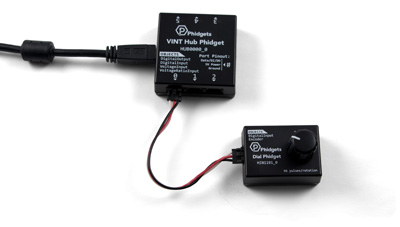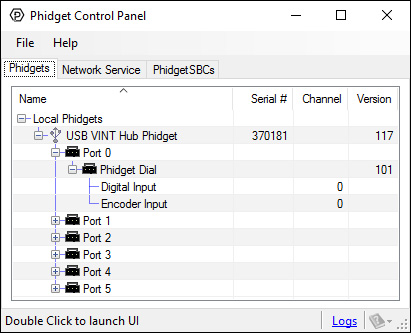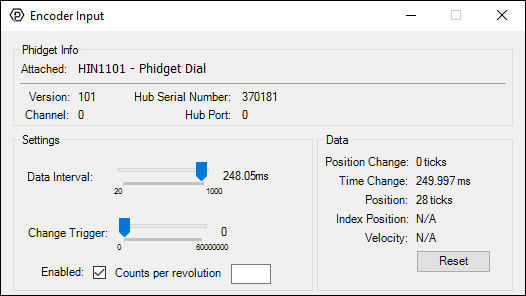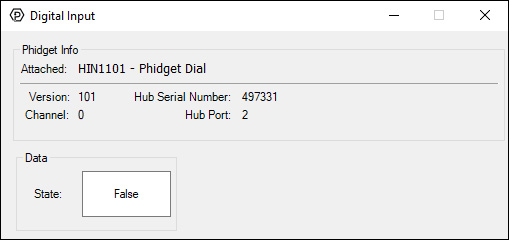HIN1101 User Guide: Difference between revisions
| Line 24: | Line 24: | ||
{{ugEncoderDial}} | {{ugEncoderDial}} | ||
{{ | {{ugDigitalInputButton|HIN1101|You can click down on the center of the dial in order to activate the digital input.}} | ||
{{ugAddressingInformation}} | {{ugAddressingInformation}} | ||
Revision as of 17:58, 28 August 2018
Getting Started
- HIN1101 Dial Phidget
- USB cable and computer
- Phidget Cable
- VINT Hub
Next, you will need to connect the pieces:

- Connect the VINT Hub to your computer with a USB cable.
- Connect the HIN1101 to the VINT Hub using the Phidget Cable.
Now that you have everything together, let's start using the HIN1101!
Using the HIN1101
Phidget Control Panel
In order to demonstrate the functionality of the HIN1101, the Phidget Control Panel running on a Windows machine will be used.
The Phidget Control Panel is available for use on both macOS and Windows machines.
Windows
To open the Phidget Control Panel on Windows, find the ![]() icon in the taskbar. If it is not there, open up the start menu and search for Phidget Control Panel
icon in the taskbar. If it is not there, open up the start menu and search for Phidget Control Panel
macOS
To open the Phidget Control Panel on macOS, open Finder and navigate to the Phidget Control Panel in the Applications list. Double click on the ![]() icon to bring up the Phidget Control Panel.
icon to bring up the Phidget Control Panel.
For more information, take a look at the getting started guide for your operating system:
Linux users can follow the getting started with Linux guide and continue reading here for more information about the HIN1101.
First Look
After plugging the HIN1101 into your computer and opening the Phidget Control Panel, you will see something like this:

The Phidget Control Panel will list all connected Phidgets and associated objects, as well as the following information:
- Serial number: allows you to differentiate between similar Phidgets.
- Channel: allows you to differentiate between similar objects on a Phidget.
- Version number: corresponds to the firmware version your Phidget is running. If your Phidget is listed in red, your firmware is out of date. Update the firmware by double-clicking the entry.
The Phidget Control Panel can also be used to test your device. Double-clicking on an object will open an example.
Encoder

When you double click on an Encoder object, a window like the one pictured will open.
- At the top of the window, information about your device and the properties of this particular channel will be listed.
- On the left, you can enable the input (if applicable) and specify the counts per revolution (CPR) to enable velocity calculation. Press enter after typing a number to enable velocity. You can also adjust the Data Interval and Change Trigger.
- On the right, real-time data is displayed:
- Position Change: The number of ticks (or quadrature cycles) that have occurred since the last change event.
- Time Change: The amount of time in milliseconds that has elapsed since the last change event.
- Position: The total position in ticks relative to where the encoder was when the window was opened.
- Index Position: Not supported by this device.
- Velocity: If a CPR has been specified, the average velocity in rotations per minute.
Digital Input (Button)
Double-click on a Digital Input Button object in order to run the example:

General information about the selected object will be displayed at the top of the window. You can also experiment with the following functionality:
- You can click down on the center of the dial in order to activate the digital input.
Finding The Addressing Information
Before you can access the device in your own code, and from our examples, you'll need to take note of the addressing parameters for your Phidget. These will indicate how the Phidget is physically connected to your application. For simplicity, these parameters can be found by clicking the button at the top of the Control Panel example for that Phidget.

In the Addressing Information window, the section above the line displays information you will need to connect to your Phidget from any application. In particular, note the Channel Class field as this will be the API you will need to use with your Phidget, and the type of example you should use to get started with it. The section below the line provides information about the network the Phidget is connected on if it is attached remotely. Keep track of these parameters moving forward, as you will need them once you start running our examples or your own code.

Using Your Own Program
You are now ready to start writing your own code for the device. The best way to do that is to start from our Phidget is compatible with the [https://www.phidgets.com/?view=code_samples&class=Encoder Encoder Examples and the DigitalInput Examples. Code Samples].
Select your programming language of choice from the drop-down list to get an example for your device. You can use the options provided to further customize the example to best suit your needs.
Once you have your example, you will need to follow the instructions on the page for your programming language to get it running. To find these instructions, select your programming language from the Programming Languages page.
What to do Next
- Programming Languages - Find your preferred programming language here and learn how to write your own code with Phidgets!
- Phidget Programming Basics - Once you have set up Phidgets to work with your programming environment, we recommend you read our page on to learn the fundamentals of programming with Phidgets.

